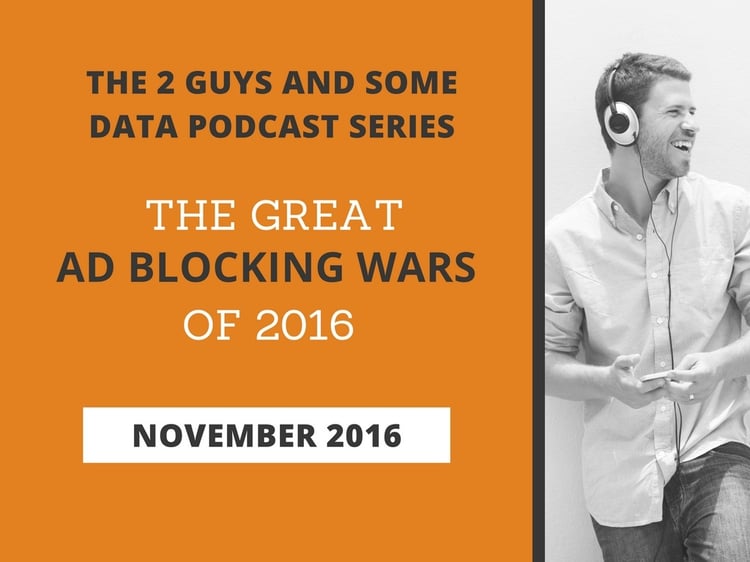It’s no secret that ad blockers are becoming more and more prominent among Web browsers, and the impact of ad blocking isn’t always readily apparent. Websites that...

2016 has seen ad blocking, and the battleground tactics used to combat it, reach new heights. But ad blocking does more than threaten advertising revenue. It could shape the collection and use of digital browsing data, which provides marketers insights into buyers' intent to purchase.
(Podcast Transcript)
Allen: Hey everyone, how are all you data-driven marketers out there today? If you're looking for new ways to reach unique prospects and better engage your audiences, well, you're in the right place. This is the third podcast for 2 Guys and Some Data series, now available on iTunes, giving you the nitty-gritty advice you need to actually make more money. I'm Allen Abbott.
Larry: And I'm Larry Kavanagh.
Allen: And today we're going to talk about the great ad blocking wars of 2016, and before you say "hey, that's not for me," hear us out. There's some very important implications surrounding the use of ad blockers, and we want to fill you in. So, Larry, why are we talking about ad blocking technology? I thought this was a podcast about data.
Larry: Well, I could say we're talking about it because you chose the topic for this month, but I think you did it because ad blocking is not what it seems. On the surface, it seems like a pretty good thing, it eliminates all those annoying digital ads. But under the hood, ad blocking ultimately can threaten the collection and use of digital browsing data. Now, browsing information today powers not only digital advertising, but triggered emails and the very cool new concept of programmatic direct mail. These new technologies have all grown at enormous rates in recent years because browsing data gives us insight into a shopper's intent in the near future. It's one of the reasons, it's really one of the main things that is helping retailers and other people who use digital advertising continue to grow their businesses. When used properly, browsing data allows marketers to send the right messages to the right consumers at the right time.
So, Allen, you always have the numbers, how prevalent is ad blocking today? Is this really a problem we should worry about?

Allen: Well, Larry, the estimates vary pretty widely, from 16% up to 25% using some type of ad blocking, and it's really spiked since iOS 9, when Apple allowed the download of ad blocking apps. Now, according to PageFair and Adobe, about $21 billion in ad revenue was lost to ad blocking software in 2015, and that number is expected to almost double in 2016. Unabated, this trend could fundamentally change our marketing options over the next two to three years. So, Larry, why are users blocking ads at such a growing rate? Don't they understand the fundamental relationship between digital ads and free content?
Larry: Heck no. Reason number one is those digital ads can be annoying. For example, I might visit a retail site, shop for a bit, then decide to leave that site and go check out the news. Okay, I'm not really checking out the news, I'm going to check on how my wide receiver might perform next week in fantasy football. My mind has switched to vital matters like "is he going to get playing time, "who's going to start," and then, as I'm really focused on trying to win this week's fantasy football, all of a sudden, ads start to show up for the retail site I was just on. The distraction is not helpful. I am not winning right now; I need to be able to focus. I want to sue for gross misuse of intent data. I'm not ready to think about buying again. So, anyway, Allen, it's like these retailers aren't using data appropriately. What do you think?
Allen: So Drew Hubbard at iMedia calls ad blocking "a consumer-driven power play: it's the masses rising up against crappy online experiences." And it's another example of advertising not honoring the implicit contract with consumers. Consumers provide lots of data, more than ever before, and in return, we owe them a personalized, unobtrusive marketing experience.
Larry: Exactly. Today's digital ads are bothersome to consumers in a number of ways. First, ads can actually slow down the load of your browser, slow down the load of the page, and when you're in a hurry to get to your content, that can really be a drag. Second, those ads can actually load malware and viruses onto your computer.
Allen: Wow, that's terrible. And those autoplay audio and video ads can scare the crap out of you if you're not expecting them.
Larry: Hey, Allen, just browse with the sound muted next time.
Allen: That's a good idea, Larry. I guess I should try that. So, Larry, what does the future look like? Are advertisers and content providers working to make the user experience better for site visitors?

Larry: Yeah, not so much. Most of the thinking today resembles battleground tactics to combat the ad blocking software that users are deploying. So, for example, Atlantic Magazine now displays a page to visitors who are using ad blocking technology that gives them three options: Whitelist their site to accept ads, pay $39.99 for one year of ad-free subscription, or go somewhere else for content. Wired is taking a similar approach. Also, according to an August 2016 report by Jack Marshall and the Wall Street Journal, Facebook is now forcing ads to appear on its desktop websites by changing the way its ads are loaded, making it harder for ad blockers to detect them. It's straight out of Spy vs. Spy.
And while I may sound cynical, and I am getting that way a little bit, what I'm about to tell you is really true. That same Wall Street Journal report talks about how Adblock Plus, one of the leading ad blocking technology, is accepting payments from 70-plus companies to whitelist their ads so they are not blocked. They should really call it "greenlist" or "goldlist," you know, "he who has the gold makes the list." All right, I'll get down from my soapbox here. Allen, how are consumers reacting to all of this?
Allen: Well, one thing is very surprising, and a free-market twist, we could call it. Consumers are actually paying a monthly fee to avoid ads. Think about Hulu, Pandora, they both have ad-free versions for a relatively modest monthly fee, and although the number of online content providers who have successfully developed a pay-for-content business model is pretty small, I can think of the Economist, the Wall Street Journal, and America's Test Kitchen, trends point to a change that could be coming. According to the American Press Institute, 53% of millennials regularly use some type of paid news content, and if that trend expands, digital display advertising opportunities could be limited in the future.
However, there's quite a few sites that just don't lend themselves to paid content. I certainly can't see Buzzfeed being able to charge to see what 22 child celebrities look like today, even if you're not going to believe #7. The real concern is a consumer revolt. If that happens, marketing effectiveness will go down, ad spend to sales ratios will go up, business profitability will tank, and lots of marketing directors and CMOs will be looking for a job, because we always get the blame when bad things happen.
Larry: Allen, Allen. Breathe, it's okay, it's okay. You know, this topic is ad blockers, not Armageddon. I'm usually the one who gets really worked up here. I have some good news for you. I can see, perhaps, a better future than what could happen. First, as marketers, we have to get smarter, or at least more relevant, with our use of web behavior, those ... You know, just haunting somebody with the same ad over site after site after site has got to have a bad effect. Work on getting the right message to the right customer at the right time. Apply some of the lessons from the cutting-edge triggered email marketers.
Second, we have to figure out what is the right advertising medium for a particular customer. Don't just stack media up blindly, hitting the same shopper with display, retargeting, text ads, PLAs, emails, Facebook ads, print, direct mail, I could go on. Optimizing the medium mix for a customer group will not only save us money as marketers, but it also dials down the annoyance factor. And finally, advertisers should be looking at other options for retargeting until the threat of ad blockers is reduced.
Allen: You know, Larry, print is a really great way to retarget consumers, and avoids the ad blocker problem almost entirely. The messaging can vary to meet the interests and needs of each individual consumer, you can target it to just most engaged shoppers, and the recipient can look at it at their leisure, without interrupting fantasy football research. So, Larry, is this the beginning of the end of free content? Is the ad-supported free content model going to disappear in the next few years?
Larry: Well, Allen, that's a great question, and that's a topic for another day. Thanks for listening to two guys ramble about data and marketing for the past few minutes. If you got what you needed, you'll probably like our blog too. Check out our resources at navistone.com/blog. Again, that's navistone.com/blog. We'll be back in a few weeks to talk about, maybe what Allen just said, or about the most lucrative data out there and how it helps you better connect with your customers. I'm Larry Kavanagh.
Allen: And I'm Allen Abbott, and have a great day.

